What Does the Leaf Clover Symbolize in Irish Culture?
The three-leaf clover, or shamrock, holds rich cultural and symbolic significance. In Irish heritage, it symbolizes good luck and national identity.
The shamrock is historically linked to St. Patrick, who is said to have used it to explain the Holy Trinity, representing faith, hope, and love.
It has a deep-rooted connection to Irish folklore and is believed to ward off evil. The clover's symbolism extends beyond just fortune and faith; it embodies resilience, trust in unseen forces, and optimism about the future.
Continue for a deeper understanding of its multifaceted meanings and modern interpretations.
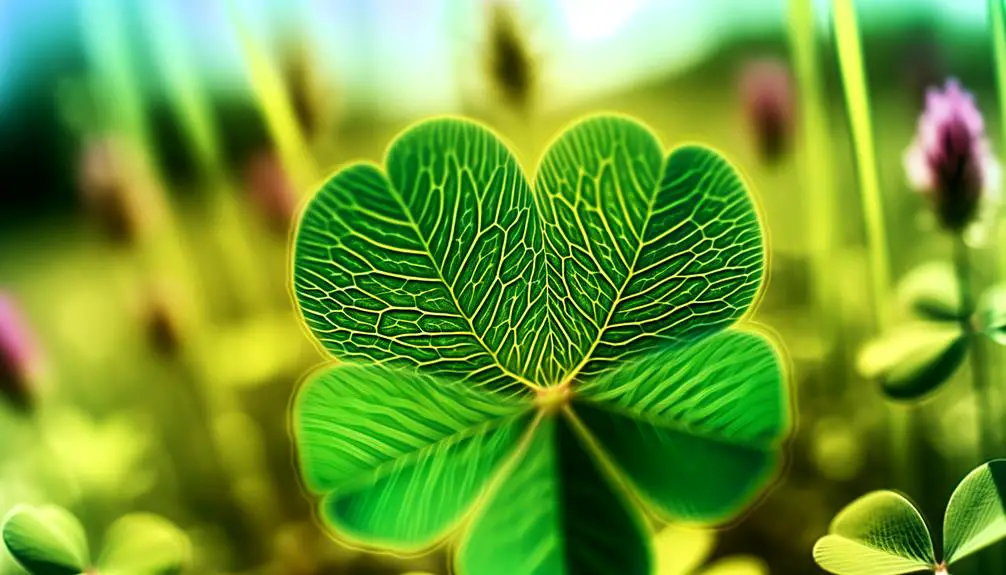
Key Takeaways
- Represents the Holy Trinity in Irish Christianity: Father, Son, and Holy Spirit.
- Symbolizes good luck and protection in Irish folklore and traditions.
- Commonly associated with St. Patrick, reflecting Irish national identity.
- Used to teach spiritual concepts in ancient Celtic culture.
- Represents hope, faith, and love, encompassing human aspirations and resilience.
Historical Background
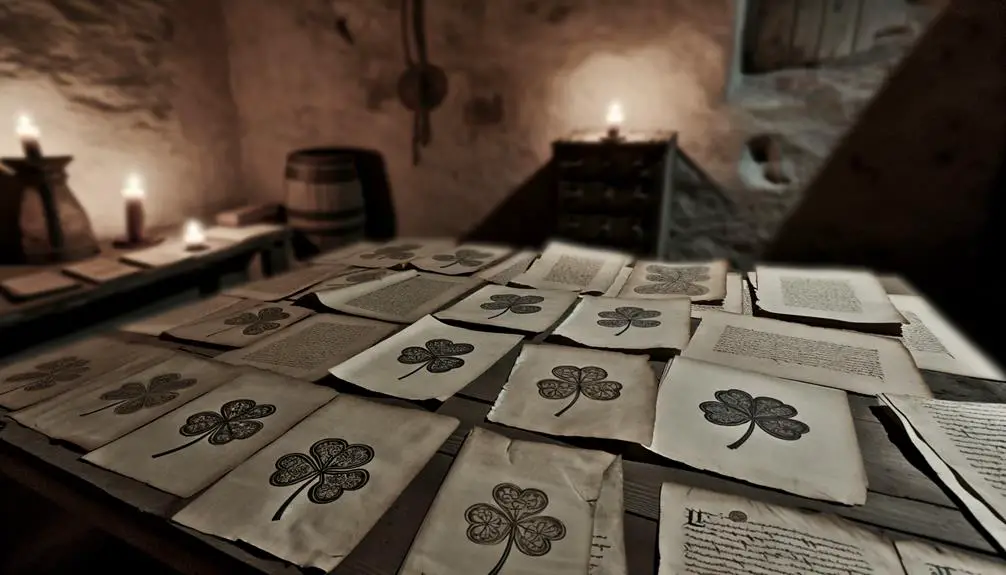
Originating from ancient traditions, the leaf clover symbol has been steeped in cultural and historical significance for centuries.
Traced back to early Celtic societies, the clover was revered as a potent emblem of protection and luck. The Druids, for instance, believed the three-leaf clover, or shamrock, held mystical properties and used it in various rituals.
As Christianity spread through Ireland, Saint Patrick famously adopted the shamrock to explain the Holy Trinity, further embedding the symbol within religious contexts.
Additionally, in various ancient cultures, the clover was seen as a representation of life and fertility, due to its hardy and proliferative nature.
Analyzing these historical narratives reveals the clover's layered meanings, deeply intertwined with both pagan and Christian traditions.
Cultural Significance
Building on its rich historical roots, the cultural significance of the leaf clover symbol manifests in diverse ways across various societies, reflecting a blend of ancient beliefs and contemporary interpretations.
In Western cultures, particularly in Ireland, the four-leaf clover is often associated with luck and prosperity, its rarity making it a potent symbol of fortune.
Meanwhile, in Eastern traditions, similar botanical symbols might represent harmony and balance, integrating seamlessly into feng shui practices and artistic expressions.
The clover's pervasive presence in folklore and modern media underscores its adaptability, allowing it to convey themes of hope, unity, and resilience.
Consequently, the leaf clover serves as a cross-cultural emblem, resonating with both historical reverence and modern-day aspirations.
Religious Symbolism
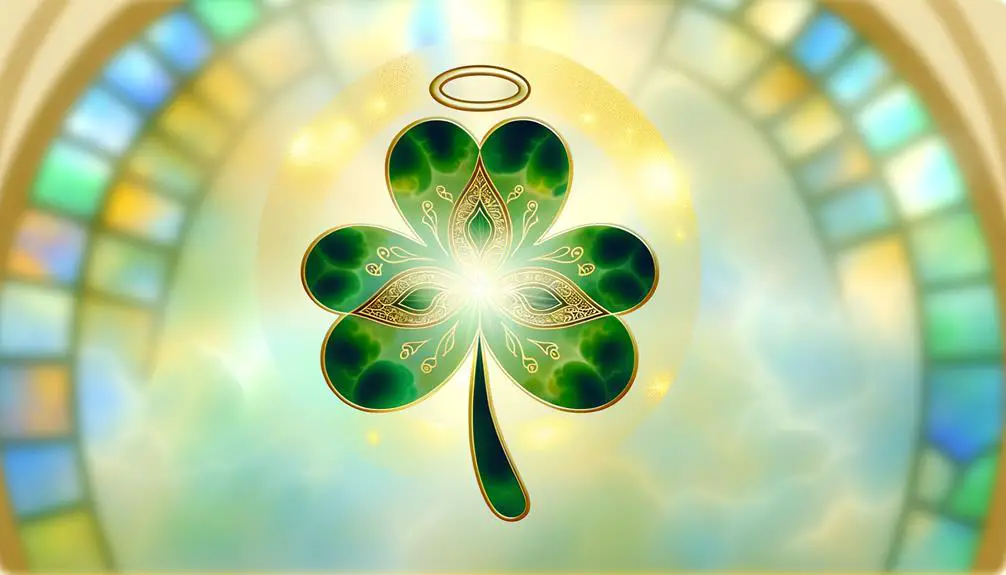
In various religious contexts, the leaf clover symbol takes on profound meanings, often intertwined with themes of faith, spirituality, and divine favor.
In Christianity, the three-leaf clover is famously associated with St. Patrick, who used it to explain the Holy Trinity—Father, Son, and Holy Spirit. This triadic symbolism underscores the unity and distinctiveness within the divine nature.
Additionally, in some interpretations, the four-leaf clover represents the cross and the Gospels, symbolizing extensive divine protection and blessing.
Beyond Christianity, the leaf clover appears in various spiritual traditions as a sign of auspiciousness and harmony. Its recurrent appearance in sacred contexts highlights its role as a bridge between the earthly and the transcendent, reinforcing its spiritual gravitas.
Folklore and Legends
Beyond its religious significance, the leaf clover also occupies a prominent place in folklore and legends, where it is often imbued with mystical properties and tales of luck, fortune, and protection. Ancient Celts believed the clover had the power to ward off evil spirits. In medieval Europe, it was thought to bring good luck, especially the rare four-leaf variant. Each leaf was believed to represent different virtues:
| Leaf Number | Symbolic Meaning |
|---|---|
| 1st Leaf | Faith |
| 2nd Leaf | Hope |
| 3rd Leaf | Love |
| 4th Leaf | Luck |
| 5th Leaf | Wealth |
These associations have profoundly influenced cultural narratives, cementing the clover's status as a powerful symbol in Western mythology.
Faith Representation
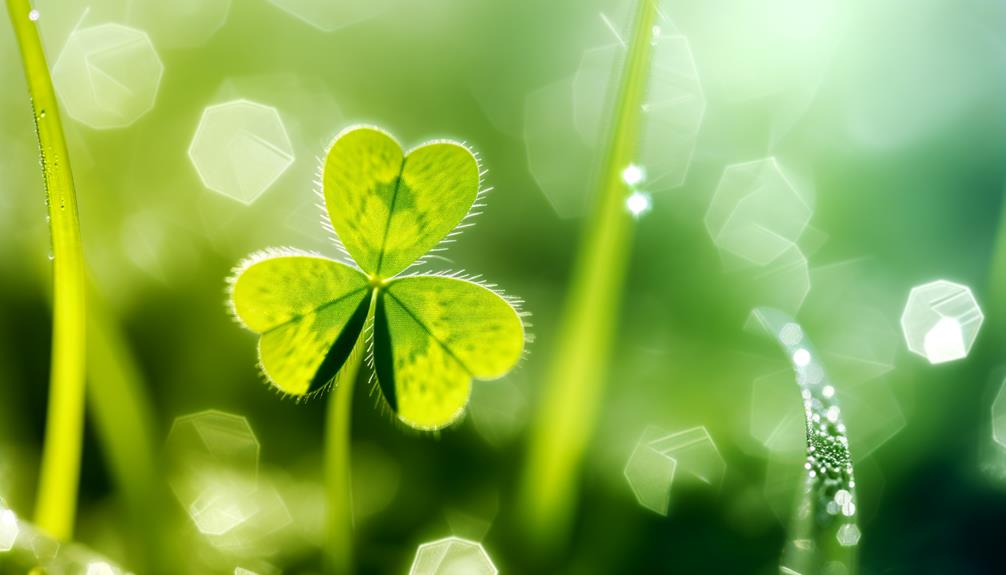
The representation of faith in the symbolism of the leaf clover is deeply rooted in its historical and cultural contexts. The first leaf is often seen as a manifestation of trust and belief in the unseen. This association dates back to ancient times when people sought signs from nature to reassure their spiritual convictions.
The first leaf, symbolizing faith, embodies the human inclination to believe in forces beyond comprehension. This notion is supported by various cultural narratives, including Celtic traditions, where the clover was seen as a bridge to otherworldly assurances.
The belief in the first leaf as a symbol of faith underscores a universal human desire for certainty in the intangible, providing a sense of comfort and spiritual grounding.
Hope Representation
Often intertwined with notions of optimism and aspiration, the second leaf of the clover symbolically represents hope, serving as a beacon for future possibilities and a reminder of resilience in the face of adversity. This symbolic hope is not merely wishful thinking but embodies a steadfast confidence in positive outcomes, even during challenging times. The clover's second leaf encapsulates this sentiment, inviting individuals to maintain a forward-looking perspective.
| Symbolic Aspect | Meaning |
|---|---|
| Optimism | Positive outlook towards future events |
| Aspiration | Desire for achieving goals and dreams |
| Resilience | Ability to withstand and recover from difficulties |
| Future Possibilities | Belief in potential positive changes and opportunities |
| Confidence | Trust in favorable outcomes and persevering action |
This table illustrates the multi-faceted dimensions of hope embedded in the clover symbol.
Love Representation
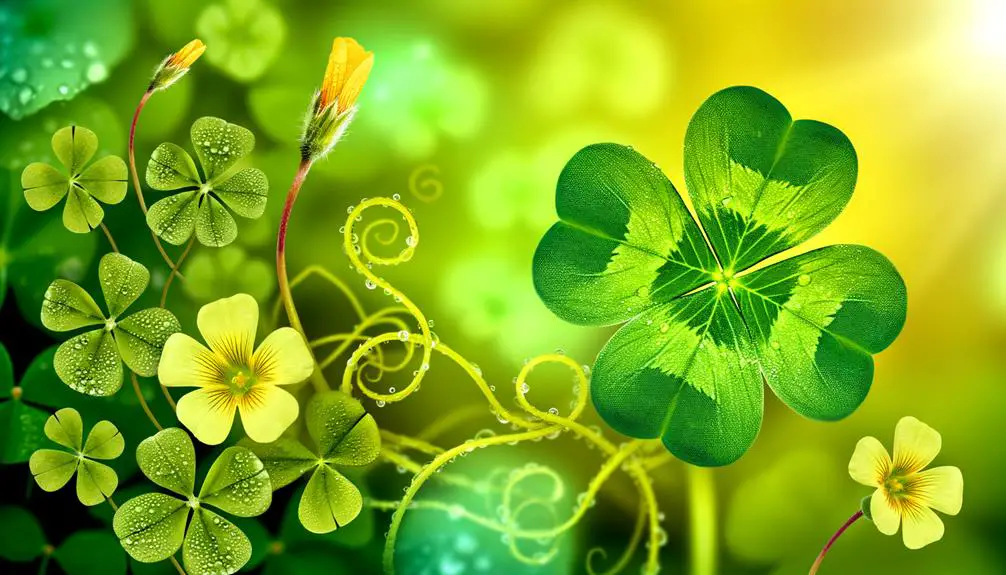
Representing the deep emotional connection and affection between individuals, the third leaf of the clover symbolizes love, encompassing a spectrum of feelings from romantic passion to familial bonds. This symbol of love is multifaceted, reflecting various dimensions that give it depth and resonance within human relationships.
Romantic Love:
The passionate connection between partners.
Familial Love:
The enduring bonds within families.
Friendship:
Platonic affection and loyalty among friends.
Self-love:
Recognizing and valuing oneself.
Universal Love:
Compassion and kindness toward humanity.
In examining these facets, one understands that the love symbolized by the third leaf of the clover is not monolithic but rather a complex, enriching force that fosters connection, empathy, and mutual support in various contexts.
Irish Heritage
Rooted deeply in Irish culture and history, the four-leaf clover has long been a symbol of good luck and prosperity, intertwining with national identity and folklore. Traditionally, the rarity of the four-leaf clover is seen as a magical anomaly, setting it apart from the ubiquitous three-leaf shamrock, which is emblematic of Ireland itself.
This rare symbol is often linked to the Druids, who believed it could ward off evil spirits. Moreover, it is said that finding a four-leaf clover would confer protection and fortune, making it a cherished emblem during times of hardship.
This cultural reverence has permeated Irish literature, art, and celebrations, solidifying the four-leaf clover's role as an enduring symbol of Irish heritage.
Botanical Characteristics
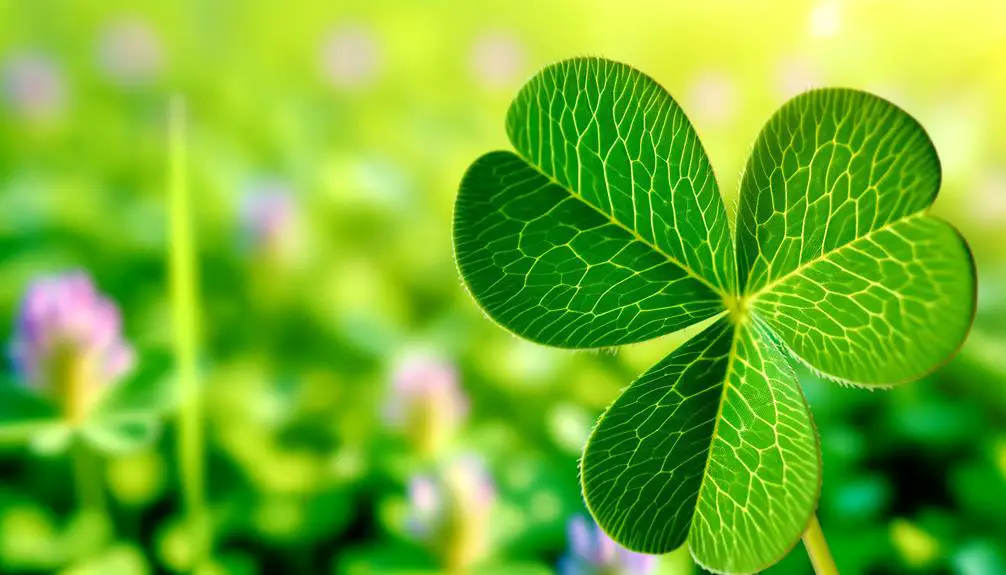
Beyond its cultural significance, the four-leaf clover's rarity can be understood through its unique botanical characteristics, distinguishing it from the more common three-leaf variants. Found prevalently within the species *Trifolium repens*, or white clover, the occurrence of four leaves results from a rare genetic mutation. This rarity is estimated at approximately 1 in 5,000 clovers, making each four-leafed specimen a notable find.
Key botanical characteristics include:
- Genetic Mutation: A rare deviation in the plant's genetic code.
- Leaf Morphology: Four distinct leaflets instead of the typical three.
- Growth Environment: Often found in nutrient-rich, well-drained soils.
- Flowering Habit: Produces small, white flowers during blooming season.
- Reproductive Strategy: Propagates through both seeds and stolons, aiding its widespread distribution.
These factors collectively contribute to its botanical uniqueness.
Modern Interpretations
The four-leaf clover has evolved to symbolize a wide array of modern interpretations, intertwining themes of luck, prosperity, and personal significance in contemporary culture.
Once a simple emblem of fortuitous chance, its meaning has broadened to encompass aspirations of success and well-being.
In personal domains, individuals may view the clover as a talisman for overcoming adversity and achieving goals. Its rarity enhances its allure, making it a metaphor for exceptional opportunities and unique life paths.
Additionally, its association with positivity extends to social and professional spheres, where it often represents good fortune in ventures and relationships.
This multifaceted symbol continues to resonate deeply, reflecting both collective hopes and individual dreams in today's complex world.
Symbolism in Art and Media
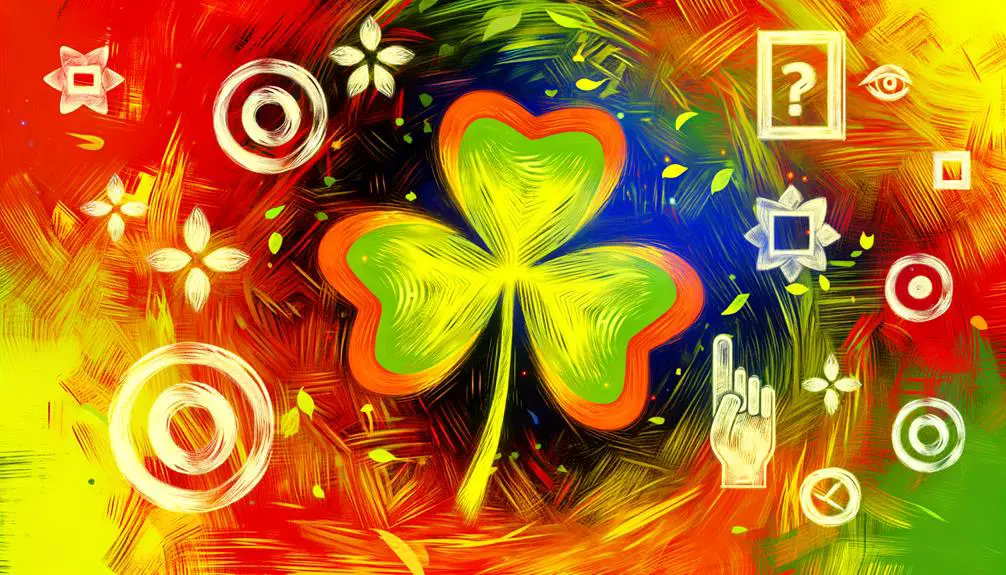
Artists and media creators have long utilized the four-leaf clover as a powerful symbol, embedding it within various forms of expression to evoke themes of luck, rarity, and aspiration. This emblematic motif often appears in:
- Visual Arts: Paintings and sculptures frequently incorporate the four-leaf clover to symbolize serendipity.
- Literature: Writers use it as a metaphor for extraordinary fortune and uniqueness.
- Film and Television: Characters finding a four-leaf clover often experience a turning point, underscoring its association with positive change.
- Graphic Design: Logos and branding elements employ the clover to convey prosperity and good fortune.
- Fashion: Designers incorporate the motif in patterns and accessories, suggesting a touch of whimsical charm.
Through these mediums, the four-leaf clover perpetuates its timeless symbolic resonance.
Conclusion
To conclude, the three-leaf clover, or shamrock, embodies a rich tapestry of historical, cultural, and religious meanings, deeply intertwined with Irish heritage and folklore.
Its representation of faith and luck persists in modern interpretations and artistic expressions. As the saying goes, 'Old symbols die hard,' underscoring the enduring significance of this botanical emblem.
The shamrock's multifaceted symbolism continues to captivate, enrich, and inform diverse cultural narratives and traditions.






